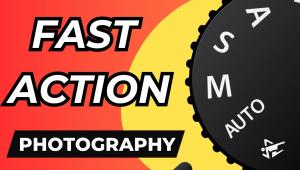Ask A Pro: Scott Kelby Answers Your Photography Questions

Ask a Pro is a new Q&A column from professional photographer, writer, and educator Scott Kelby. Scott is here to answer all your photography-related questions, so if you have something you’d like to know, e-mail him at editorial@shutterbug.com (with “For Scott Kelby” as the subject line) and your query could be featured in the next edition of Ask a Pro.
Q. I’ve heard you say that you frequently use a 70-200mm f/2.8 lens (usually at the 200mm length) for shooting portraits. But I also read that you recommend and like the 85mm f/1.2 (or f/1.4 or f/1.8) for portraits as well. So, what is your criteria for deciding when to use each lens for portraits?
A. I only use the 85mm for outdoor portraits, where I’ll be able to take advantage of a super shallow depth of field at f/stops like f/1.4 or f/1.8. That’s a lot harder to do in a studio situation where you’re more likely to be around f/11 (because even when you lower the power of your strobes all the way down, it’s still too much light to shoot at f/1.4 without adding a neutral density filter over your lens and stuff like that). So, that’s pretty much my criteria. I do use the 70-200mm f/2.8 outdoors a lot as well, and in those cases I only shoot it at f/2.8. However, the 85mm really doesn’t come indoors very often (maybe at a wedding when I can shoot in natural light, but outside of that, it’s an outdoor lens for me). Hope that helps.
Q. I’m struggling to get sharp portraits with my 85mm f/1.4 lens. Only every fourth or fifth shot is in sharp focus. I hear so many photographers raving about this lens, but I have so many out-of-focus shots that I’m ready to return it. Is there a setting I need to change in the camera that will help?
A. Here’s the good news: your lens probably isn’t messed up (so don’t return it), and there isn’t some secret camera setting you need to fix the problem. What will help is using a different focusing technique when you’re using these super-fast (low numbered f/stop) lenses that will get nearly all your shots in focus. It’s kind of the opposite to what we do when we’re using our regular lenses. Normally, we’d place the focus dot (or rectangle) over our subject’s eye (well, the eye that’s closest to the camera), press the shutter button down halfway to lock focus, then we recompose the shot the way we want it, and press the shutter button when our subject gives us the expression we’re looking for, right? Right. That’s what we normally do, except that doesn’t work with these super-fast lenses with a crazy shallow depth of field at f/stops like f/1.2, f/1.4, and even f/1.8. Instead you need to: (a) compose the shot first, (b) use the joystick or toggle on the back of your camera to move that focus dot (or rectangle) over your subject’s eye manually, and when your subject gives you the expression you’re looking for, then you take the shot. No “lock focus first then recompose.” Instead it’s “compose first, then move the focus point, then take the shot.” Also, it helps to keep the camera on somewhat of an even plane (or axis) just straight up and down, or straight left and right, but that’s after you’ve changed how you focus and compose for these super-fast lenses.
Q. I’m new to sports photography and want to do a better job shooting my son’s team during this hockey season. Your article in the November issue on tips for shooting sports photography was very informative and offered a clear explanation on the relationship between ISO, aperture, and shutter speed. Do you have any recommendations for a setup that is specific to hockey arenas and action shots in low-light conditions?
A. I use the same settings for shooting NHL Hockey: I shoot wide open at the lowest-numbered aperture I can, either f/2.8 or f/4 depending on the lens I’m using, with one exception—I set my ISO to “Auto ISO” and then set my minimum shutter speed allowable to 1/1000 of a second. That way, no matter where they are on the ice, I won’t get a blurry shot. I might get a bit of a noisier shot, but if you give me the choice between a shot that’s a little noisy or a little blurry, I’ll take noisy every time. My biggest struggle shooting hockey is white balance—the ice should be white, and if your white balance is 100 percent on, you’ll get either bluish ice or yellowish ice, and neither one looks right. I do see some guys out there using a gray card and setting it that way, but I just get as close as I can in camera. I use Live View mode to set my white balance because you can change white balance while the image is live on the back of your camera. When you find the one where the ice looks white, stick with that one and then exit out of Live View mode. If you still have tint problems on the ice, you’ll have to fix it in post.
Q. While I don’t have a problem with my prints coming out too dark, I have an issue with them having a color cast, which is usually green. They look OK on the screen but they are not printing correctly. I have an Epson XP-800 printer. Does this mean I need to buy something to calibrate my screen and if so, what is a good option for someone on a budget?
A. Without using some kind of a hardware calibration device, it’s going to be tough to get a dead-on match with your printer and monitor, so you’ll need to start with a hardware calibrator. I use the Spyder 5 hardware calibrator. It’s not too expensive, and beats the heck out of making prints that make you mad. Start with it. (By the way, today the process of calibrating your monitor is automated—just hang the measuring device over on your monitor; run the software, and it does the rest.) Once your monitor is calibrated, then you’ll need to go to the website of the company that makes the brand of paper you’re printing on. For example, if you’re printing on Canon paper, you need to go download the free Canon color profile for the exact paper you’re printing on, and for the exact printer you’ll be printing to. Then, when you’re printing (I’m assuming out of Photoshop or Lightroom), you’ll need to choose that printer. That’ll get you really close. There is a little more to it than this (not a whole lot thankfully), but it’s beyond the scope of this Q&A column.
Scott Kelby is a photographer, Photoshop Guy, award-winning author of more than 50 books, and CEO of KelbyOne, an online education community dedicated to helping photographers take the kinds of images they’ve always dreamed of. You can learn more about Scott at his daily blog (scottkelby.com), or follow him on twitter: @scottkelby.
(Editor’s Note: Ask a Pro is a new Q&A column from professional photographer, writer, and educator Scott Kelby. Scott is here to answer all your photography-related questions, so if you have something you’d like to know, e-mail him at editorial@shutterbug.com (with “For Scott Kelby” as the subject line) and your query could be featured in the next edition of Ask a Pro.)
















































